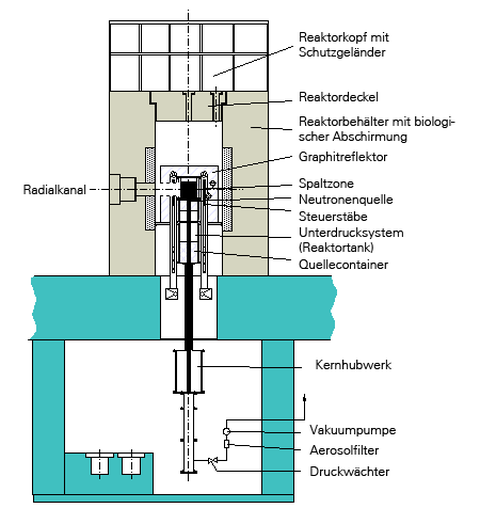System description
The training nuclear reactor of the Chair of Hydrogen and Nuclear Energy Technology is a homogeneous solid-fuel moderated zero-power reactor. The reactor first went critical as AKR-1 on July 28, 1978. The cylindrical fission zone has a diameter of 250 mm, a critical height of 275 mm and is constructed from plate-shaped fuel elements. The fuel element plates consist of a homogeneous mixture of uranium oxide (enrichment < 20 % U-235) and polyethylene as a moderator material. The fission zone contains a total of 794 g U-235.
The maximum continuous output of the reactor is 2 watts. The system is controlled by three combined control and safety rods made of cadmium. The start-up neutron source (Am-Be; neutron source strength 2.2-106 s-1) is located inside the reactor to ensure a safe start. The fission zone is surrounded on all sides by a reflector made of high-purity graphite. The cylindrical reactor vessel as the outer casing is made of heavy concrete with a wall thickness of approx. 75 cm and is mainly used for radiation shielding.
To carry out experiments, the AKR has the central channel leading through the fission zone and five further experimental channels. At a reactor power of 2 watts, the flux density of thermal neutrons in the middle of the central experimental channel is approx. 2.5-107 cm-2 s-1. Two channels with a clear diameter of 75 mm are located tangentially to the fission zone in the reflector.
The reactor is designed in such a way that a prompt supercritical state cannot be caused by incorrect operation under any circumstances. Unacceptable increases in power are impossible and therefore a risk to the operating personnel, the environment and the reactor is excluded for physical reasons. To this end, the excess reactivity was limited to a maximum of 0.3 % and the escape of fission products was prevented by a multi-barrier system.
The reactor facility is mainly used for training and teaching purposes, but is also an instrument for research work in national and international projects.


